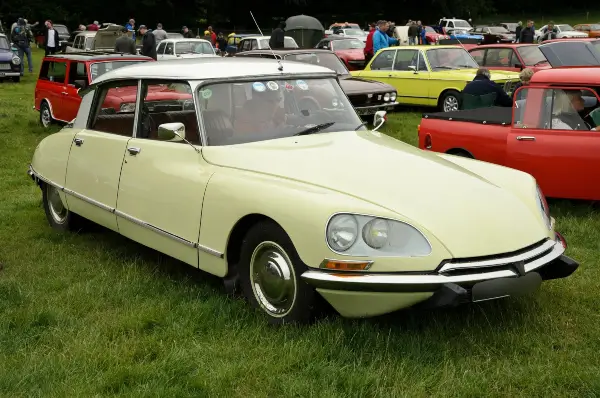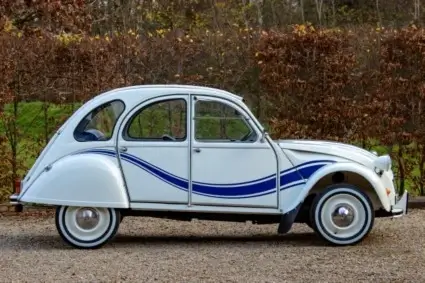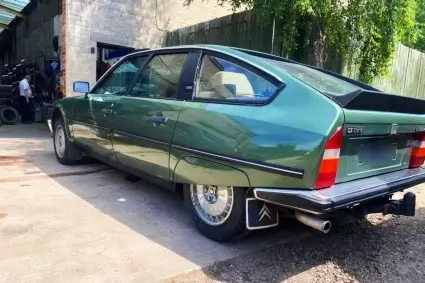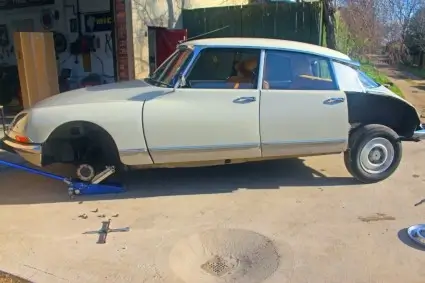-
- Citroen Ami Tyres
- Citroen Birotor Tyres
- Citroen B14 Tyres
- Citroen CX Tyres
- Citroen C4 Tyres
- Citroen C6 Tyres
- Citroen DS Tyres
- Citroen Dyane Tyres
- Citroen GS Tyres
- Citroen ID Tyres
- Citroen Mehari Tyres
- Citroen SM Tyres
- Citroen Traction Avant Tyres
- Citroen 2CV Tyres
- Citroen 5CV Tyres
- Citroen 7CV Tyres
- Citroen 8CV Tyres
- Citroen 9CV
- Citroen 10CV Tyres
Citroen Tyres
Classic Citroen Tyres
Classic Citroen Tyres
On the following pages, Longstone Classic Tyres give classic tyre fitment recommendations for Citroen cars.
Michelin Citroen Tyres
The following list demonstrates Michelin's tyre range intended for Citroen:
- 13 x 45 Michelin DR for Citroen C4 and B14.
- 14 x 45 Michelin DR original equipment for Citroen C6.
- 130/140 x 40 Michelin SCSS for the Citroen 8cv, 7A and 7B.
- 150/160 x 40 Michelin SCSS for pre-war and early post-war Citroen Traction Avante 10 and 11cv.
- 125 R 400 Michelin X for early Citroen 2cv.
- 155 R 400 Michelin X and 165 SR 400 Michelin X for early DS and ID.
- 180 HR 15 Michelin XAS for the front of a Citroen DS (occasionally a 155 HR 15 XAS for the rears).
- 145 SR 15 Michelin XZX for the Citroen GS.
- 205/70 VR 15 Michelin XWX for the Citroen SM.
- 210/55 VR 390 Michelin TRX is still in production for the Citroen CX GTi.
01302 711 123
or
Email: [email protected]
Citroen History

Automobiles Citroen S.A was formed in 1919 by Andre-Gustave Citroen. Andre was a French businessman and freemason who used to manufacture armaments in large quantities. However, he became interested in the motor sector in the mid-1910s. After World War I, he used to found Citroen, a corporation named after himself. Citroen's first automobile, the Type A, was presented with a unique advertisement. It was a vintage automobile with a four-cylinder engine and a maximum speed of 64 kilometres per hour. The car quickly became a hit in the French automobile market, and this marked the start of a thriving corporation. Citroen began mass-producing automobiles with basic designs in 1920, which serviced the expanding automotive industry admirably. In just one year on the market, the firm sold over 10,000 automobiles. Citroen introduced their second model, the B2, in 1921, which proved to be a more powerful version of the Type A.
Citroen managed to increase its production rate to 50000 units two years later, and by 1927 (just eight years after its foundation), it had risen to become the world's fourth-biggest vehicle manufacturer. In 1931, Citroen launched the Citroen C4F, the world's first front-wheel-drive automobile, and three years later, Citroen introduced the Traction Avant, the world's first front-wheel-drive car.
A prototype of one of Citroen's most popular automobiles, the 2CV, made its appearance at the end of the 1930s. However, owing to the Javel Factory explosion in the 1940s, the firm was unable to continue manufacturing. Despite this, Citroen was able to conceal prototypes of the 2CV, which were eventually built in 1948. The 2CV is believed to have sold to the tune of over 5 million vehicles. Citroen introduced the Type HZ, a little van, at the end of the 1940s. In addition, due to the petrol crisis, the corporation was able to include gas as an option on the majority of its cars. Citroen created a van version of the iconic 2CV in the 1950s that could travel 100 kilometres per 5 gallons.
A year later, the Citroen 15 CV debuted as the official automobile of the French government. Citroen automobiles had considerable styling modifications and were more contemporary throughout this period. After producing over 750,000 Traction Avants, the business discontinued manufacture in 1958.
With the unveiling of the DS 19 in Paris, the firm made a good start to the new decade. It was one of the first Citroen vehicles to be available in 76 distinct colour combinations and a large variety of personalization options. The death of Flaminio Bertoni, Citroen's principal designer and the man behind the renowned DS 19 and Ami 6, in 1964 was a severe blow to the firm.
Citroen outperformed the competition once more in 1969 when it released the DS 21, the first French production car with electronic fuel injection. Two years later, the Citroen GS received the 'Car of the Year' title, and several additional popular models were built and introduced during the 1970s. Citroen DS 23, Citroen Ami Super, Citroen CX, Dyane Caban, and CX 2400 GTI were among them. Fiat purchased a 30% stake in Citroen in 1976, establishing the parent firm, PSA Peugeot Citroen, which is today the second-largest European carmaker and the ninth-largest by unit output.



